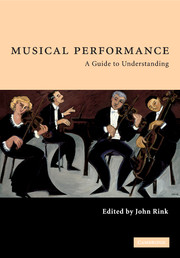10 - Communicating with the body in performance
Published online by Cambridge University Press: 05 June 2012
Summary
Introduction
This chapter describes the important role of ‘presentation’ in solo performances within the classical tradition. As a starting point it acknowledges the huge transition between the isolation of individual practice and the social interactions experienced on the concert platform. It will argue that the work that takes place in rehearsal must anticipate the social context of the performance and the inevitable physiological and psychological arousal that situation will bring; it will also consider the need for performance to be both spontaneous and alive to the social dynamic of the performing experience. Central to this discussion is the visual aspect of presentation. It is critical to note the manifold assessments that occur between performer and audience, on the basis of information from such visual cues as dress code, general mannerisms and other non-verbal behaviours like the direction of gaze and the physical gestures made when playing.
The role of practice
Research has shown that musical expertise involves high-level refinement of both mental and physical activity to such a degree that the relationship between the information stored in memory, the mental plans and schemes which organise these memories, and associated thoughts and physical actions becomes completely automatic and fluent. Practice is central to achieving this fluency. In the early stages of learning, thoughts and actions are initially clumsy, deliberate and difficult to coordinate, but with large amounts of practice and experience, a musician can play without conscious attention to the thoughts and actions used in the production of the performance.
- Type
- Chapter
- Information
- Musical PerformanceA Guide to Understanding, pp. 144 - 152Publisher: Cambridge University PressPrint publication year: 2002
References
- 10
- Cited by



